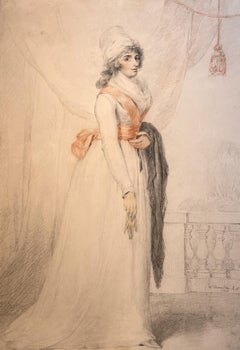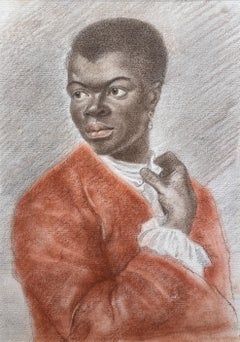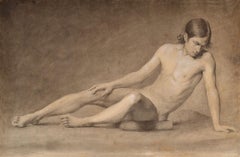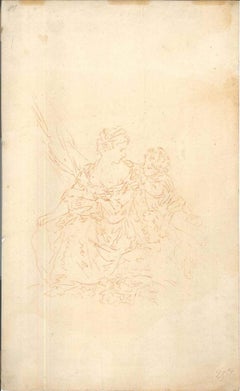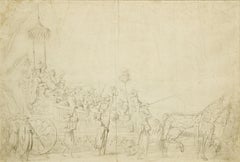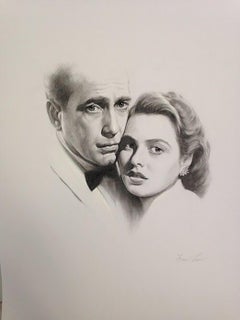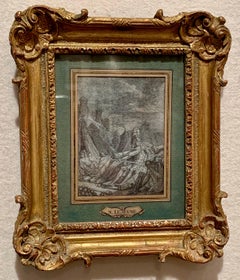Art by Medium: Charcoal
to
1
5
3
2
3
2
3
2
Overall Height
to
Overall Width
to
3
5
3
2
2
1
1
1
1
1
1
1
1
6
112
1,270
2,410
39
39
65
98
56
82
150
124
82
73
5
1
3,798
3,030
1,202
854
725
Period: 18th Century
Medium: Charcoal
Portrait of Mrs Sarah Kembel Siddons
Located in London, GB
Charcoal and sanguine on paper, signed and dated '1793' lower right
Image size: 21 x 14 1/2 inches (53.25 x 37 cm)
Framed
Provenance
Collection of Mr and Mrs John Whitehead (England), collection of the Duchess of Rutland (Wales), collection of Mr Michael W. Murphy (El Dorado).
Exhibitions
No.97, 'National Portraits', The South Kensington Museum (V&A), 1868 (label on reverse).
Sarah Siddons was a welsh actress and the best-known tragedienne of the 18th century. Siddons's first major success came in 1782 with her portrayal of Isabella in the Fatal Marriage, written by David Garrick the leading actor-manager of the period. Siddons continued to dominate the London stage until her farewell in 1812.
Part of a powerful theatrical dynasty, her brothers were the actors Philip and Charles Kemble, her husband was the actor William Siddons and her son, Henry Siddons was also an actor. She was hailed as the chief interpreter of Shakespeare. Her masterpiece was Lady Macbeth as she excelled in roles that allowed her to combine passionate intelligence with pathos. The critic William Hazlitt proclaimed her 'tragedy personified'.
William Hamilton
William Hamilton RA (1751–1801) was an English painter and illustrator. Hamilton was born in Chelsea, London, but travelled and worked in Italy with Antonio Zucchi...
Category
1790s Victorian Art by Medium: Charcoal
Materials
Paper, Pencil, Charcoal
18th Century Italian Old Master Drawing Nude Figure Sketches Male & Female
Located in Cirencester, Gloucestershire
Figurative Sketches
Italian School, mid 18th century
circle of Pompeo Batoni (1707-1787)
charcoal and pencil, heightened with white chalk, unframed...
Category
Mid-18th Century Old Masters Art by Medium: Charcoal
Materials
Pencil, Charcoal, Chalk
Portrait of a Young Man Original Charcoal and Pastel French 18th Century
Located in London, GB
French School
18th Century
Portrait of a Young Man
Charcoal and pastel on paper
Image size: 11 x 7 inches
Contemporary gilt frame
Category
18th Century Rococo Art by Medium: Charcoal
Materials
Paper, Charcoal, Pastel
Reclining Youth, 18th Century Nude Graphite on Paper
Located in London, GB
French School
18th Century
Reclining Youth
Graphite and charcoal on paper
Image size: 15 x 23 inches (38 x 58.5 cm)
Wash line mount and gilt frame
Painting in eighteenth-century Fra...
Category
18th Century Old Masters Art by Medium: Charcoal
Materials
Graphite, Charcoal
Female figure with Child and Dog - Charcoal Drawing
Located in Roma, IT
Female figure with child and dog is a sublime original drawing (red chalk drawing on laid paper) by an exponent of the French School of the XVIII century...
Category
18th Century Old Masters Art by Medium: Charcoal
Materials
Charcoal
Related Items
Study for « The Chinese Masquerade » by Jean-Baptiste Pierre (1714 - 1789)
By Jean-Baptiste Pierre
Located in PARIS, FR
Arriving in Rome in June 1735 as a resident at the Royal Academy, Pierre was unable to attend the Winter Carnival festivities of 1735, which he nevertheless immortalised in an engrav...
Category
1730s Old Masters Art by Medium: Charcoal
Materials
Graphite
Casablaca
Located in Fort Washington, PA
Medium: Charcoal, White Pastel on Canson MiTientes Paper
Signature: Signed Lower Right
Dimensions: 25.00" x 19.00" Unframed
Category
20th Century Art by Medium: Charcoal
Materials
Paper, Charcoal, Pastel
Marilyn Unzipped
Located in Fort Washington, PA
Medium: Charcoal, White Pastel on Canson MiTientes Paper
Signature: Signed Lower Right
Dimensions: 25.00" x 19.00" Unframed
Category
20th Century Art by Medium: Charcoal
Materials
Charcoal, Paper, Pastel
Dorothy and Toto
Located in Fort Washington, PA
Medium: Charcoal and White Pastel on Canson MiTientes paper
Signature: Signed Lower Right
Dimensions: 25.00" x 19.00" Unframed
Category
20th Century Art by Medium: Charcoal
Materials
Charcoal, Paper, Pastel
Nudo maschile nella posa di un satiro dormiente. XIX secolo
Located in Firenze, IT
Disegno del nudo maschile.
Dal 19 ° secolo
Disegno su carta leggermente colorata.
In buone condizioni.
Il disegno rappresenta un uomo sdraiato, che si abbandona al sonno.
In una posa...
Category
19th Century Academic Art by Medium: Charcoal
Materials
Paper, Carbon Pencil
Free Shipping
H 13.39 in W 18.51 in D 0.04 in
The Abduction of the Sabine Women , a Renaissance drawing by Biagio Pupini
Located in PARIS, FR
This vigorous drawing has long been attributed to Polidoro da Caravaggio: The Abduction of the Sabine Women is one of the scenes that Polidoro depicted between 1525 and 1527 on the façade of the Milesi Palazzo in Rome. However, the proximity to another drawing inspired by this same façade, kept at the Ecole des Beaux-Arts, and to other drawings inspired by Polidoro kept at the Musée du Louvre, leads us to propose an attribution to Biagio Pupini, a Bolognese artist whose life remains barely known, despite the abundant number of drawings attributed to him.
1. Biagio Pupini, a Bolognese artist in the light of the Roman Renaissance
The early life of Biagio Pupini, an important figure of the first half of the Cinquecento in Bologna - Vasari mentions him several times - is still poorly known. Neither his date of birth (probably around 1490-1495) nor his training are known. He is said to have been a pupil of Francesco Francia (1450 - 1517) and his name appears for the first time in 1511 in a contract with the painter Bagnacavallo (c. 1484 - 1542) for the frescoes of a church in Faenza. He then collaborated with Girolamo da Carpi, at San Michele in Bosco and at the villa of Belriguardo.
He must have gone to Rome for the first time with Bagnacavallo between 1511 and 1519. There he discovered the art of Raphael, with whom he might have worked, and that of Polidoro da Caravaggio. This first visit, and those that followed, were the occasion for an intense study of ancient and modern art, as illustrated by his abundant graphic production.
Polidoro da Caravaggio had a particular influence on the technique adopted by Pupini. Executed on coloured paper, his drawings generally combine pen, brown ink and wash with abundant highlights of white gouache, as in the drawing presented here.
2. The Abduction of the Sabine Women
Our drawing is an adaptation of a fresco painted between 1525 and 1527 by Polidoro da Caravaggio on the façade of the Milesi Palace in Rome. These painted façades were very famous from the moment they were painted and inspired many artists during their stay in Rome. These frescoes are now very deteriorated and difficult to see, as the palace is in a rather narrow street.
The episode of the abduction of the Sabine women (which appears in the centre of the photo above) is a historical theme that goes back to the origins of Rome and is recounted both by Titus Livius (Ab Urbe condita I,13), by Ovid (Fasti III, 199-228) and by Plutarch (II, Romulus 14-19). After killing his twin brother Romus, Romulus populates the city of Rome by opening it up to refugees and brigands and finds himself with an excess of men. Because of their reputation, none of the inhabitants of the neighbouring cities want to give them their daughters in marriage. The Romans then decide to invite their Sabine neighbours to a great feast during which they slaughter the Sabines and kidnap their daughters.
The engraving made by Giovanni Battista Gallestruzzi (1618 - 1677) around 1656-1658 gives us a good understanding of the Polidoro fresco, allowing us to see how Biagio Pupini reworked the scene to extract this dynamic group.
With a remarkable economy of means, Biagio Pupini takes over the left-hand side of the fresco and depicts in a very dense space two main groups, each consisting of a Roman and a Sabine, completed by a group of three soldiers in the background (which seems to differ quite significantly from Polidoro's composition).
The balance of the drawing is based on a very strongly structured composition. The drawing is organised around a median vertical axis, which runs along both the elbow of the kidnapped Sabine on the left and the foot of her captor, and the two main diagonals, reinforced by four secondary diagonals. This diamond-shaped structure creates an extremely dynamic space, in which centripetal movements (the legs of the Sabine on the right, the arm of the soldier on the back at the top right) and centrifugal movements (the arm of the kidnapper on the left and the legs of the Sabine he is carrying away, the arm of the Sabine on the right) oppose each other, giving the drawing the appearance of a whirlpool around a central point of support situated slightly to the left of the navel of the kidnapper on the right.
3. Polidoro da Caravaggio, and the decorations of Roman palaces
Polidoro da Caravaggio was a paradoxical artist who entered Raphael's (1483 - 1520) workshop at a very young age, when he oversaw the Lodges in the Vatican. Most of his Roman work, which was the peak of his career, has disappeared, as he specialised in facade painting, and yet these paintings, which are eminently visible in urban spaces, have influenced generations of artists who copied them abundantly during their visits to Rome.
Polidoro Caldara was born in Caravaggio around 1495-1500 (the birthplace of Michelangelo Merisi, known as Caravaggio, who was born there in 1571), some forty kilometres east of Milan. According to Vasari, he arrived as a mason on the Vatican's construction site and joined Raphael's workshop around 1517 (at the age of eighteen according to Vasari). This integration would have allowed Polidoro to work not only on the frescoes of the Lodges, but also on some of the frescoes of the Chambers, as well as on the flat of Cardinal Bibiena in the Vatican.
After Raphael's death in 1520, Polidoro worked first with Perin del Vaga before joining forces with Maturino of Florence (1490 - 1528), whom he had also known in Raphael's workshop. Together they specialised in the painting of palace façades. They were to produce some forty façades decorated with grisaille paintings imitating antique bas-reliefs.
The Sack of Rome in 1527, during which his friend Maturino was killed, led Polidoro to flee first to Naples (where he had already stayed in 1523), then to Messina. It was while he was preparing his return to the peninsula that he was murdered by one of his assistants, Tonno Calabrese, in 1543.
In his Vite, Vasari celebrated Polidoro as the greatest façade decorator of his time, noting that "there is no flat, palace, garden or villa in Rome that does not contain a work by Polidoro". Polidoro's facade decorations, most of which have disappeared as they were displayed in the open air, constitute the most important lost chapter of Roman art of the Cinquecento. The few surviving drawings of the painter can, however, give an idea of the original appearance of his murals and show that he was an artist of remarkable and highly original genius.
4. The façade of the Milesi Palace
Giovanni Antonio Milesi, who commissioned this palace, located not far from the Tiber, north of Piazza Navona, was a native of the Bergamo area, like Polidoro, with whom he maintained close friendly ties. Executed in the last years before the Sack of Rome, around 1526-1527, the decoration of Palazzo Milesi is considered Polidoro's greatest decorative success.
An engraving by Ernesto Maccari made at the end of the nineteenth century allows us to understand the general balance of this façade, which was still well preserved at the time. The frescoes were not entirely monochrome, but alternated elements in chiaroscuro simulating marble bas-reliefs and those in ochre simulating bronze and gold vases...
Category
16th Century Old Masters Art by Medium: Charcoal
Materials
Ink, Gouache, Pen
Preparatory anatomical study for the figure of a man with hands on his face.
Located in Firenze, IT
Preparatory anatomical study for the figure of a man with hands on his face.
Drawing of a medium-sized male nude.
From the 19th century
Drawing on slightly greyish colored paper.
In ...
Category
Late 19th Century Academic Art by Medium: Charcoal
Materials
Gesso, Paper, Charcoal, Carbon Pencil
Free Shipping
H 17.72 in W 13.39 in
MB 827 (Contemporary Life Drawing of Two Nude Males by Mark Beard)
By Mark Beard
Located in Hudson, NY
Academic life drawing of two nude males with charcoal and graphite by Mark Beard, "MB 827"
graphite, Conte crayon and charcoal on Arches paper
29.75 x 21.75 inches unframed
Signed, l...
Category
2010s Contemporary Art by Medium: Charcoal
Materials
Charcoal, Archival Paper, Graphite, Conté
H 29.75 in W 21.75 in
Costume drawings for ‘Ambassadeur de Siam’ and ‘La Sultana Reine’
Located in Amsterdam, NL
Joseph-Marie Vien (1716-1809)
‘Ambassadeur de Siam’ and ‘La Sultana Reine’
Both titled lower centre, the drawing of the ambassador inscribed with colours intended for the prints, e...
Category
Mid-18th Century Old Masters Art by Medium: Charcoal
Materials
Paper, Pencil
Free Shipping
H 9.26 in W 6.89 in D 1.19 in
MB 085A (Contemporary Life Drawing of Nude Male by Mark Beard)
By Mark Beard
Located in Hudson, NY
Academic life drawing of male nude with charcoal and graphite by Mark Beard, "MB 085A"
graphite, Conte crayon and charcoal on Arches paper
30 x 18.5 inches unframed
Signed, lower rig...
Category
2010s Contemporary Art by Medium: Charcoal
Materials
Charcoal, Archival Paper, Graphite, Conté
MB 702 (Contemporary Life Drawing of Male Nude by Mark Beard)
By Mark Beard
Located in Hudson, NY
MB 702 (Contemporary Life Drawing of Male Nude by Mark Beard)
graphite, Conte crayon and charcoal on Arches paper
30 x 19 inches unframed
Con...
Category
2010s Contemporary Art by Medium: Charcoal
Materials
Conté, Charcoal, Archival Paper, Graphite
The body of a slim young man. 1970s. Marco Silombria signed.
Located in Firenze, IT
The body of a slim young man. 1970s. Marco Silombria signed.
Marco Silombria, Italian advertising graphic designer, artist and ceramist.
charcoal and wax on paper.
Signed bottom righ...
Category
1970s Pop Art Art by Medium: Charcoal
Materials
Paper, Charcoal, Wax Crayon
H 17.72 in W 27.56 in D 0.08 in
Previously Available Items
FINE 18th CENTURY OLD MASTER CHARCOAL DRAWING - THE LAMENTATION OF CHRIST
Located in Cirencester, Gloucestershire
Artist/ School: French School, 18th century
Title: The Lamentation.
Medium: charcoal on paper, mounted.
Size: drawing: 13 x 15.5 inches
Provenance: private collection,...
Category
Mid-18th Century Old Masters Art by Medium: Charcoal
Materials
Charcoal, Pencil
Series of 18th century French gouache and chalk classical old master subjects
Located in Woodbury, CT
An amazing collection of 18th century gouache and chalk/charcoal draawings by this well known French artist. Each has been framed and matted in the most amazing frames which set the ...
Category
1780s Old Masters Art by Medium: Charcoal
Materials
Charcoal, Gouache, Chalk
Free Shipping
H 6 in W 5 in
Martyrdom of Saint Caecilian
By Domenico Gabbiani (attr.)
Located in Roma, IT
Martyrdom of Saint Caecilian is a valuable original drawing (black chalk, pen and China ink, brush and wash on laid paper, backed) by a member of the Tuscan School of the XVIII centu...
Category
18th Century Old Masters Art by Medium: Charcoal
Materials
Charcoal, Ink, Watercolor
Anatomic study of Faces
Located in Roma, IT
Anatomic study of faces is a sublime original drawing (red chalk drawing on laid and watermarked paper at the center) by an exponent of the Italian School of the XVIII century.
In ve...
Category
18th Century Old Masters Art by Medium: Charcoal
Materials
Charcoal
Charcoal art for sale on 1stDibs.
Find a wide variety of authentic Charcoal art available on 1stDibs. While artists have worked in this medium across a range of time periods, art made with this material during the 21st Century is especially popular. There are many well-known artists whose body of work includes ceramic sculptures. Popular artists on 1stDibs associated with pieces like this include Robert Lebsack, Pamela Holmes, Federico Castellon, and Richard Shaoul. Frequently made by artists working in the Contemporary, Abstract, all of these pieces for sale are unique and many will draw the attention of guests in your home. Not every interior allows for large Charcoal art, so small editions measuring 1 inches across are also available Prices for art made by famous or emerging artists can differ depending on medium, time period and other attributes. On 1stDibs, the price for these items starts at $1 and tops out at $1,450,000, while the average work can sell for $1,424.
Recently Viewed
View AllMore Ways To Browse
Vintage Mid Century Oil Paintings
Wall Sculpture Black And White
Vintage Vinyl Covers
Vintage Vinyl Cover
Hanging Screen
Service The Japanese
Fashion 1968
Cathedral Style
Car Poster
Car Posters
Contemporary Textile Wall Art
Saint Jacques
Colorful Wood Wall Art
Silver Japanese Painting
31 Women
Chinese Calligraphy Art
Dior Silver Frame
Virgin Painting
